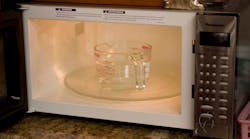At a Glance:
- Researchers studying the nonuniform heating of liquids in microwaves simulate thermal conductivity of liquids and show why microwaving liquids differs from other techniques.
- Using cut-off waveguide theory, an ordinary glass is modified in a simple and effective way to evenly distribute heat in a common household flat-panel microwave oven.
The convenience of boiling water in the microwave comes with trade-offs. Firstly, when the water is not heated long enough, it will not heat uniformly, and secondly, using the wrong container can result in harmful explosions.
Heating water in a microwave is unlike heating water on the stovetop. With the stove, the liquid toward the bottom of the kettle warms up first, becomes less dense and moves to the top, while a cooler part of the water moves closer to the source of heat. This process is called convection and explains the uniform temperature derived from heating liquids on the stove.
In contrast, when water is heated in a microwave, electromagnetic waves in the oven will heat water molecules at random spots. However, when a container of water is placed in the microwave, the electric field acting as the heat source inside the microwave will heat up the entire container at once, explained researchers at the University of Electronic Science & Technology of China. In this case, the liquid at the top of the glass is much hotter than the liquid at the bottom.
The researchers, who studied the nonuniform heating of liquids in microwaves, offer a solution for heating water evenly in microwaves. Extrapolating from waveguide theory, they designed a silver plating to go along the rim of a glass. In waveguide theory, electromagnetic waves below the cut-off frequency will produce attenuation in the waveguide.
The modified glass is placed in the center of the ceramic plate, far away from the microwave’s cavity wall. The silver rim on the glass creates a buffer against the effects of the microwave at the surface of the liquid, noted the researchers. The silver rim acts as a guide for the waves and reduces the electric field at the top of the glass. As a result, the water at the top of the glass is not heated by the microwaves. This cut-off waveguide method creates a convection process similar to traditional stovetop heating, they explained, resulting in a more uniform temperature.
Placing metals, such as silver, in the microwave may seem unsafe as it conducts electricity. Metals placed in the microwave contain electrons, which reflect microwaves. Without sufficient material in the microwave to absorb the reflected microwaves, arcing (sparks) may occur between the metal object and a part of the microwave. The researchers pointed out, however, that similar metal structures with finely tuned geometry can avoid ignition, and that this configuration has been safely used for microwave steam pots and rice cookers.
“After carefully designing the metal structure at the appropriate size, the metal edge, which is prone to ignition, is located at weak field strength, where it can completely avoid ignition, so it is still safe,” said Baoqing Zeng, one of the authors on the paper and professor of electronic science and engineering at UESTC.
Going forward, the research group is considering other ways to improve nonuniformity in solid foods, although the methods are currently too expensive for practical use, they said. They are also working with a microwave manufacturer to commercialize their microwave accessories for liquids.
Journal Reference
Peiyang Zhao, Weiwei Gan, Chuanqi Feng, Zhongxing Qu, Jianlong Liu, Zhe Wu, Yubin Gong, Baoqing Zeng. “Multiphysics analysis for unusual heat convection in microwave heating liquid.” AIP Advances, 2020; 10 (8): 085201 DOI: 10.1063/5.0013295


